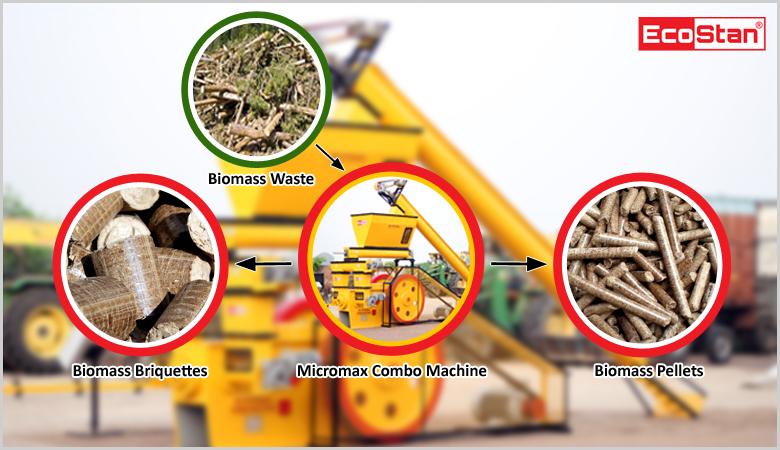With the assistance of charcoal powder, the charcoal briquette is manufactured with the help of a briquette machine, which is used as fuel. Charcoal briquettes produce heat in a large amount without generating too much smoke during burning. Therefore, it has been extensively used in industrial and domestic applications in recent years and has become the most popular fuel in India as well as in other countries. Let’s take a look at the ingredients of charcoal briquettes and the charcoal briquette-making process:
Composition Of Charcoal Briquettes
The two primary components of a charcoal briquette are the heat-producing charcoal and the optional additives. The process of pyrolysis in an air-isolated environment or incomplete combustion of wood or wood raw materials produces charcoal. It can be used as fuel because carbon is its primary constituent. White ash, briquette binder, and accelerants are the minor constituents.
Charcoal
More than 70% of the total charcoal briquettes are made of charcoal. Various kinds of wood, including beech, birch, hard maple, pecan, and oak, can be used as the raw materials for charcoal as the combustion process that produces heat. The kiln primarily handles charcoal processing. Blackwood charcoal is the general name for the charcoal created and burned in the kiln. It has the benefit of being simple to light, but because it burns quickly and produces a lot of smoke, it is simple to explode during burning. However, after being carbonized, taken out of the kiln, and quenched in wet sand, white wood charcoal can undergo oxidation and produce white ash. Its texture is tougher than that of black wood charcoal.
Catalysts
The burning of the charcoal briquette cannot fully contact oxygen, hence an accelerator is required to speed up combustion. The best accelerator is a nitrate, which may speed up combustion by both supplying oxygen and heat during combustion. But the price is prohibitive. 10% to 20% of sawdust can be added to efficiently boost burning speed as a great accelerator at a cheaper cost.
White Ash
White ash, one of the minor components, makes up only 2% to 3% of the charcoal briquette. However, it is crucial to the way charcoal briquettes are burned. We can determine how well a charcoal briquette is burning by looking at how white it becomes. The white ash’s non-combustibility also effectively lengthens the burning time.
Briquette Binder
In order to make charcoal briquettes, a binder must be added because the material lacks flexibility. About 5% to 7% of the charcoal briquettes contain a binder. Numerous facts demonstrate that starch performs best as a binding substance. After it has gelatinized, a thick paste can be created to help the charcoal powder adhere to one another for easier briquette formation later on. Acacia gum also referred to as Arabic gum, is a common briquette binder. However, waste paper pulp is the best option when costs are taken into account. The finished product will differ if the composition ratios are different.
Advantages Of Charcoal Briquettes
Smokeless and tasteless
Lighter
Cheaper than lumpy charcoal
Easy to handle, pack, transport, and use
Briquette-making process
High combustion value
Longer burning time as well as a more uniform and stable burning process
How To Make Charcoal Briquettes?
Most individuals are interested in learning how to make charcoal briquettes in a briquette machine. There are five phases involved in creating charcoal briquettes:
Carbonization
First, the rotary kiln heats the raw materials. The temperature must be kept between 840 and 950 degrees Fahrenheit (450 and 510 degrees Celsius) throughout the one-week combustion phase. Close the air inlet once combustion is complete, and then close the exhaust hole after one to two hours of exhaust. Crush the carbonized wood once the kiln has been empty for two weeks (charcoal).
Crushing
Crush the carbonized wood using a hammer crusher or roller crusher. Although various types of wood, including bark, dry wood chips, wet wood, and so forth, should be crushed to a variety of sizes, in general, they can be crushed into pieces of charcoal to a thickness of 5 mm or less to produce high-quality charcoal briquettes.
Drying
After that, drying is required. It is simple to start an explosion if the water content is beyond the empirical upper limit because this will cause the temperature to rise and the volume to abruptly expand. It will be challenging for mold to grow if the moisture content is too low. Use a dryer to reduce the material’s moisture content to 15%, or about half the amount needed to make briquettes.
Briquette Production
A crucial phase in the shaping of charcoal is briquetting. The primary driving force of the briquette machine, the friction force, and the centripetal force of the wall will all be applied to the raw materials when they enter the ball press. The charcoal briquettes can keep their shape when they drop from the bottom of the machine because of moisture, adhesives, temperature (about 105 °F or 40 °C), and pressure of the rollers.
Drying in Briquette Machine
Feed the charcoal briquettes into the dryer and let them run for three to four hours so they can reach 275 °F (135 °C) and lose around 5% of their moisture. After manufacture, immediately bag the charcoal briquettes or silo them. The aforementioned steps will result in the production of charcoal briquettes at a rate of 2200–20,000 pounds (1–9 metric tonnes) per hour.
Final Words
I hope, you have gained all the essential information about charcoal briquettes, and understand its process. Besides, if you want to buy a Briquette cum Pellet machine at a reasonable price, check out ecostan.com, where you will get high-quality briquette machines.









































